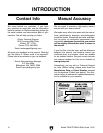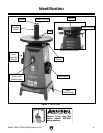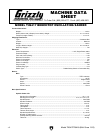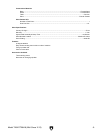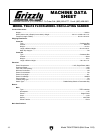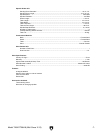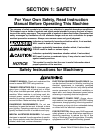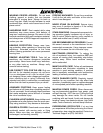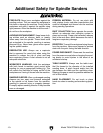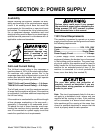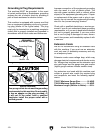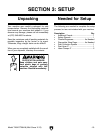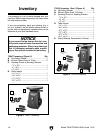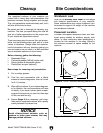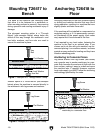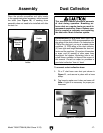
-10-
Model T26417/T26418 (Mfd. Since 11/13)
FEED RATE. Never jam a workpiece against the
sanding surface. This can cause the workpiece to
kick back or damage the machine. Firmly hold the
workpiece and ease it against the spindle using
light pressure. Allow the machine to do the work—
do not force the workpiece.
AVOIDING ENTANGLEMENT. Keep loose cloth-
ing articles such as sleeves, belts, or jewelry
items away from the spindle. These items could
get entangled in the spindle, resulting in serious
personal injury. Never wear gloves when operat-
ing the spindle sander.
RESPIRATOR USE. Always use a respirator
that is approved for wood dust when using this
machine to reduce the risk of short and long
term respiratory illness. A dust collector is not an
adequate substitute.
WORKPIECE HANDLING. Hold the workpiece
with both hands to maintain good control while
sanding (or use an appropriate holding jig). This
will reduce the likelihood of losing control of the
workpiece and having it thrown from the machine.
SANDING SLEEVES. Worn or damaged sanding
sleeves can tear apart and become entangled
in the spindle or be thrown from the machine,
resulting in personal injury or property damage.
Promptly replace sanding sleeves if they become
worn or damaged.
FOREIGN MATERIAL. Do not use stock with
nails, staples, knots, and other imperfections that
could be dislodged and thrown from the machine
during sanding operations.
DUST COLLECTION. Never operate the sander
without an adequate dust collection system in
place and running. Proper dust collection reduces
dust in the work area, which decreases the risk of
long-term respiratory damage.
DIRECTION. To avoid the workpiece being thrown
from the machine. Never sand tapered or pointed
stock with the point facing the feed direction.
POWER DISCONNECT. Disconnect the machine
from the power source before changing the sand-
ing sleeve to avoid injuries in the event of an
accidental startup.
TABLE INSERTS. Always use the table insert
that fits closest to the diameter of the installed
sanding drum. A pinch hazard exists from the
gap between the table and the oscillating drum.
Keeping this gap as small as possible reduces the
risk of this hazard.
HAND PLACEMENT. Do not touch or place
hands too close to sanding surfaces during opera-
tion.
Additional Safety for Spindle Sanders



